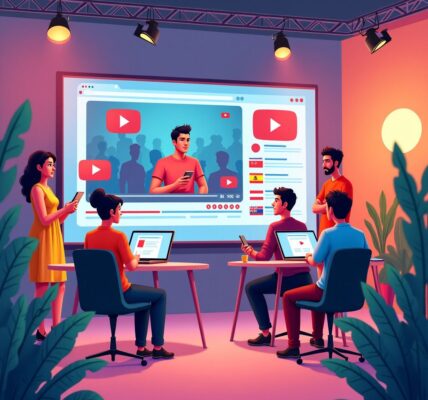In the ever-evolving landscape of social media, understanding the algorithms that govern how content is distributed is crucial for maximizing our reach and engagement. Each platform has its unique set of rules and criteria that determine what content gets seen by users. For instance, Facebook prioritizes content that sparks meaningful interactions among users, favoring posts that generate comments and shares over mere likes.
This means that we must focus on creating engaging content that encourages conversations, rather than simply broadcasting our messages. Similarly, Instagram’s algorithm emphasizes visual appeal and user engagement. It rewards posts that receive quick interactions shortly after being published, which means we need to be strategic about when we share our content.
On platforms like Twitter, the fast-paced nature of the feed means that timing is everything; tweets can quickly become buried under a deluge of new posts. By understanding these nuances, we can tailor our strategies to align with each platform’s specific algorithm, ensuring that our content reaches the widest audience possible.
Key Takeaways
- Each social media platform has its own unique algorithm that determines how content is displayed to users.
- Identifying the best times to post on each platform can significantly increase engagement and reach.
- Utilizing scheduling tools and apps can help streamline the posting process and ensure consistent content delivery.
- Creating a content calendar can help maintain a consistent posting schedule and ensure a variety of content types.
- Tailoring content for different time zones can help reach a global audience and maximize engagement.
Identifying the Best Times to Post on Each Platform
Identifying the optimal times to post on social media is a critical step in enhancing our visibility and engagement. Research indicates that different platforms have varying peak usage times, influenced by user demographics and behaviors. For instance, studies suggest that Facebook users are most active during weekday afternoons, while Instagram engagement tends to peak in the evenings and on weekends.
Moreover, it’s essential to consider the nature of our audience when determining the best posting times. If we are targeting a professional demographic, for example, posting during lunch hours or after work may yield better results.
Conversely, if our audience consists of younger individuals or students, late-night posts might be more effective. By experimenting with different posting times and closely monitoring engagement levels, we can refine our approach and ensure that our content reaches its intended audience at the right moment.
Utilizing Scheduling Tools and Apps

In our quest for social media success, utilizing scheduling tools and apps can significantly streamline our efforts. These tools allow us to plan and automate our posts across various platforms, freeing up valuable time for us to focus on content creation and engagement. Popular options like Hootsuite, Buffer, and Later enable us to schedule posts in advance, ensuring that we maintain a consistent presence even during busy periods.
Additionally, these tools often come equipped with analytics features that provide insights into our audience’s behavior and engagement patterns. By leveraging this data, we can make informed decisions about our posting strategies and adjust our content accordingly. Scheduling tools not only enhance our efficiency but also empower us to maintain a steady flow of content, which is essential for keeping our audience engaged and informed.
Creating a Content Calendar
Creating a content calendar is an invaluable practice that helps us stay organized and focused in our social media efforts. A well-structured calendar allows us to plan our posts in advance, ensuring that we cover a diverse range of topics and formats while aligning with key dates and events relevant to our audience. By mapping out our content strategy over weeks or months, we can maintain a cohesive narrative and avoid last-minute scrambling for ideas.
This strategic approach not only enhances our brand image but also fosters trust and loyalty among our followers. By regularly reviewing and updating our calendar based on performance metrics and audience feedback, we can continuously refine our strategy and ensure that we are meeting the needs of our community.
Tailoring Content for Different Time Zones
In today’s globalized world, tailoring our content for different time zones is essential for maximizing engagement across diverse audiences. As we expand our reach beyond local boundaries, we must consider the varying schedules of our followers in different regions. This means being mindful of when our target audiences are most active online and adjusting our posting times accordingly.
For instance, if we have a significant following in both North America and Europe, we may need to stagger our posts to accommodate both time zones effectively. This could involve scheduling certain posts for early morning in one region while targeting late afternoon or evening in another. By being strategic about timing and considering the cultural nuances of each region, we can create a more personalized experience for our followers, ultimately leading to higher engagement rates.
Monitoring and Analyzing Engagement Metrics

Monitoring and analyzing engagement metrics is a fundamental aspect of any successful social media strategy. By keeping a close eye on key performance indicators such as likes, shares, comments, and click-through rates, we can gain valuable insights into what resonates with our audience. This data-driven approach allows us to identify trends and patterns in user behavior, enabling us to refine our content strategy over time.
Furthermore, analyzing engagement metrics helps us understand which types of content perform best on each platform. For example, if we notice that video content consistently garners higher engagement than static images on Instagram, we can prioritize video production in our content calendar. By regularly reviewing these metrics and adjusting our strategies accordingly, we can ensure that we are continually meeting the needs of our audience while maximizing our reach.
Adjusting Schedules Based on Performance Data
As we gather insights from our engagement metrics, it becomes imperative to adjust our posting schedules based on performance data. If certain posts consistently perform well at specific times or days of the week, we should consider prioritizing those slots in our content calendar. Conversely, if we notice that certain times yield low engagement rates, it may be time to rethink our approach.
Flexibility is key in this process; social media trends can shift rapidly, and what works today may not be effective tomorrow. By remaining agile and responsive to performance data, we can optimize our posting schedules to align with current audience behaviors. This iterative approach not only enhances our overall strategy but also demonstrates to our followers that we are attentive to their preferences and needs.
Engaging with Followers in Real Time
Engaging with followers in real time is an essential component of building a strong online community. Social media is inherently interactive; it thrives on conversations and connections between brands and their audiences. By actively responding to comments, messages, and mentions as they come in, we foster a sense of community and encourage further interaction.
Real-time engagement also allows us to address questions or concerns promptly, demonstrating that we value our followers’ input and feedback. This responsiveness can significantly enhance brand loyalty and trust among our audience. Additionally, hosting live Q&A sessions or interactive polls can further deepen this connection by providing followers with opportunities to engage directly with us in meaningful ways.
In conclusion, navigating the complexities of social media requires a multifaceted approach that encompasses understanding algorithms, optimizing posting times, utilizing scheduling tools, creating structured content calendars, tailoring content for diverse audiences, monitoring engagement metrics, adjusting strategies based on performance data, and engaging with followers in real time. By implementing these strategies collectively, we can enhance our social media presence and foster lasting connections with our audience.
FAQs
What is social media scheduling?
Social media scheduling is the process of planning and organizing social media posts in advance using a scheduling tool or platform. This allows users to create and schedule posts to be published at specific times and dates, ensuring a consistent and timely presence on social media.
Why is scheduling social media posts important?
Scheduling social media posts is important for maintaining a consistent and active presence on social media platforms. It allows users to plan and organize their content in advance, ensuring that posts are published at optimal times for maximum reach and engagement. Additionally, scheduling posts can help save time and streamline the social media management process.
What are the benefits of scheduling social media posts?
Some benefits of scheduling social media posts include:
– Consistent and timely posting
– Time-saving and efficiency
– Ability to reach global audiences in different time zones
– Improved organization and planning
– Increased engagement and reach
How can I schedule social media posts for optimal reach and engagement?
To schedule social media posts for optimal reach and engagement, consider the following tips:
– Use analytics to determine the best times to post for your specific audience
– Tailor your content to each social media platform
– Utilize scheduling tools and platforms to plan and organize your posts
– Engage with your audience in real-time to maximize reach and impact
– Monitor and analyze the performance of your scheduled posts to make adjustments as needed












